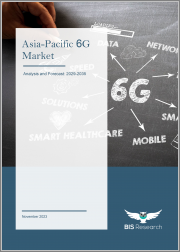
|
시장보고서
상품코드
1374893
아시아태평양의 6G 시장 분석과 예측(2029-2035년)Asia-Pacific 6G Market - Analysis and Forecast, 2029-2035 |
||||||
중국을 제외한 아시아태평양의 6G 시장 규모는 2028년 3억 달러에서 예측 기간 동안 106.42%의 CAGR을 기록하며 2035년 2,759억 1,000만 달러 규모로 성장할 것으로 예상됩니다.
이 시장의 성장 요인은 주로 빠르고 안정적인 연결에 대한 수요 증가와 첨단 기술 채택에 기인합니다. 데이터 집약적 애플리케이션의 수요 증가와 AR, VR, IoT와 같은 기술의 등장에 따른 수요 증가에 대응하기 위해 수요가 급증하고 있습니다.
세계는 점점 더 상호 연결되고 디지털 기술에 대한 의존도가 높아지고 있습니다. 이에 따라 다양한 애플리케이션을 지원할 수 있는 더 빠르고 안정적인 네트워크가 요구되고 있습니다. 고해상도 컨텐츠 스트리밍부터 실시간 통신, 자율주행차, 스마트 시티와 같은 신흥 기술에 전력을 공급하는 것까지, 초고속, 고신뢰성 연결에 대한 수요는 빠르게 증가할 것으로 예상됩니다. 6세대(6G) 기술은 전례 없는 속도와 최소한의 대기 시간으로 원활한 연결성을 제공함으로써 이러한 수요에 대응할 수 있도록 설계되었으며, 다양한 산업에 혁명을 일으키고 개인과 기업 모두의 디지털 경험 전반을 향상시킬 것입니다.
한편, 복잡한 인프라 요구 사항과 투자 필요성은 성장을 억제하는 도전이 될 것으로 예상됩니다. 장비, 주파수 대역 할당 및 네트워크 구축에 많은 투자가 필요하기 때문에 6G 인프라를 구축하는 데 많은 투자가 필요합니다. 또한, 5G 네트워크 구축에는 네트워크 사업자, 정부, 기술 제공업체 등 다양한 이해관계자 간의 광범위한 계획, 조정 및 협력이 필요합니다. 또한, 네트워크 도입은 규제 문제에 직면할 수 있으며, 새로운 표준과 프로토콜을 개발해야 합니다.
| 주요 시장 통계 | |
|---|---|
| 예측 기간 | 2029-2035년 |
| 2029년 평가 | 35억 7,000만 달러 |
| 2035년 전망 | 2,759억 1,000만 달러 |
| CAGR | 106.42% |
시장 구분:
세분화 1: 최종사용자별
- 소비자용
- 산업 및 기업용
세분화: 소비자용별
- 모바일
- M2M 통신
- 컴퓨팅
세분화: 산업용 및 기업용별
- 인더스트리 4.0
- 스마트 시티 및 도시 인프라
- E-Healthcare
- 자율주행차
- 기타
세분화 2: 제품 유형별
- 디바이스
- 통신 인프라
세분화 3: 재료 유형별
- 플라스틱 및 수지
- 세라믹 및 복합재료
- 유리
- 반도체 재료
- 기타
세분화 4: 지역별
- 중국
- 아시아태평양 및 일본 : 일본, 한국, 인도, 호주, 기타
본 보고서는 아시아태평양의 6G 시장을 조사했으며, 시장 개요, 시장 성장에 영향을 미치는 각종 요인 분석, 규제 환경, 시장 규모 추이 및 예측, 각종 부문별·주요 국가별 상세 분석, 경쟁 상황, 주요 기업 분석 등의 정보를 정리하여 전해드립니다.
목차
제1장 시장
- 업계 전망
- 동향 : 현재와 미래
- 공급망 분석
- 생태계/진행중인 프로그램
- 이해관계자 분석
- 6G를 지지하는 기술
- 5G에서 6G로의 이동
- 비지니스 역학
- 사업 촉진요인
- 사업상 과제
- 사업 기회
- 사업 전략
- 경영 전략
- 스타트업 상황
- 특허 분석
- 사례 연구
제2장 지역
- 중국
- 시장별
- 응용별
- 제품별
- 아시아태평양과 일본
- 시장별
- 응용별
- 제품별
- 아시아태평양 및 일본의 6G 시장 : 국가별
- 아시아태평양과 일본 : 국가별
제3장 시장 : 경쟁 벤치마킹과 기업 개요
- 경쟁 벤치마킹
- 주요 기업의 제품 매트릭스
- 주요 기업의 시장 점유율 분석
- 기업 개요
- Reliance Industries Limited.
- Samsung Electronics Co., Ltd.
- China Unicom(Hong Kong) Limited
- MediaTek Inc.
- SK Telecom Co., Ltd.
- Nippon Telegraph and Telephone Corporation
- Huawei Technologies Co., Ltd.
- ZTE Corporation
- Resonac Holdings Corporation
- DAIKIN INDUSTRIES, Ltd.
제4장 조사 방법
ksm 23.11.16“The Asia-Pacific 6G Market (excluding China) Expected to Reach $275.91 Billion by 2035.”
The Asia-Pacific 6G market (excluding China) is projected to be $0.30 billion in 2028, and it is expected to grow at a CAGR of 106.42% and reach $275.91 billion by 2035.
| KEY MARKET STATISTICS | |
|---|---|
| Forecast Period | 2029 - 2035 |
| 2029 Evaluation | $3.57 Billion |
| 2035 Forecast | $275.91 Billion |
| CAGR | 106.42% |
The driving force behind the expansion of the APAC 6G market is primarily the escalating demand for high-speed and dependable connectivity, coupled with the adoption of cutting-edge technologies. This surge in demand is a response to the increasing need for businesses and consumers to meet the growing demands of data-intensive applications and the emergence of technologies such as augmented reality, virtual reality, and the Internet of Things (IoT).
Driver: Accelerating Demand for Ultra-High-Speed and Reliable Connectivity
The world is becoming progressively interconnected and reliant on digital technologies, resulting in a heightened requirement for faster and more reliable networks that can support a wide array of applications. From streaming high-definition content to enabling real-time communication and powering emerging technologies like autonomous vehicles and smart cities, the demand for ultra-high-speed and reliable connectivity is expected to experience rapid growth. 6G technology is designed to address this demand by offering unprecedented speeds, minimal latency, and seamless connectivity, thus revolutionizing various industries and enhancing the overall digital experience for both individuals and businesses.
Restraint: Complex Infrastructure Requirements and Investment Challenges
The establishment of the infrastructure for 6G necessitates significant investments in equipment, spectrum allocation, and network deployment. Deploying 6G networks also demands extensive planning, coordination, and collaboration among various stakeholders, including network operators, governments, and technology providers. Moreover, implementing the networks may encounter regulatory challenges and require the development of new standards and protocols.
Opportunity: Unlocking Innovation and New Business Models
The ultra-high-speed, low latency, and extensive connectivity capabilities of 6G networks present opportunities for transformative applications and services. Industries like healthcare, transportation, manufacturing, and entertainment can harness the potential of 6G to enhance efficiency, boost productivity, and provide immersive experiences. Additionally, the introduction of 6G technology can pave the way for the emergence of new business models, facilitating innovative revenue streams and economic growth.
Challenge: Ensuring Data Security and Privacy in a Connected World
With the proliferation of connected devices and the rise of data-driven applications, there is a pressing need for robust security measures to safeguard sensitive information and prevent unauthorized access. The challenge is in the development of advanced encryption protocols, the implementation of secure authentication mechanisms, and the establishment of stringent data protection regulations. Additionally, as 6G networks enable the collection of vast amounts of data, there is a need for effective data governance frameworks to ensure transparency, accountability, and user consent in the handling of confidential information.
6G Market Ecosystem
The APAC 6G market is propelled by leading companies that have established themselves as industry leaders. These companies possess financial stability, a proven track record in delivering innovative telecommunications solutions and services, and a diverse product portfolio spanning infrastructure, devices, applications, and services. They are well-equipped with state-of-the-art technologies and extensive research and development capabilities, positioning them at the forefront of driving the advancement of technology.
Market Segmentation:
Segmentation 1: by End-Use Application
- Consumer Application
- Industrial and Enterprise
Segmentation: by Consumer Application
- Mobile
- M2M Communication
- Computing
Segmentation: by Industrial and Enterprise
- Industry 4.0
- Smart City and Urban Infrastructure
- E-Healthcare
- Autonomous Vehicles
- Others
Segmentation 2: by Product Type
- Device
- Communication Infrastructure
Segmentation 3: by Material Type
- Plastics and Resins
- Ceramics and Composites
- Glass
- Semiconductor Materials
- Others
Segmentation 4: by Region
- China
- Asia-Pacific and Japan: Japan, South Korea, India, Australia, and Rest-of-Asia-Pacific and Japan
The study includes a comprehensive competitive analysis of these key players in the APAC 6G market, featuring their company profiles, recent developments, and key market strategies. These players have embraced various growth strategies, such as partnerships, agreements and collaborations, product launches and enhancements, and acquisitions, to expand their presence in the market."
Table of Contents
1 Markets
- 1.1 Industry Outlook
- 1.1.1 Trends: Current and Future
- 1.1.1.1 Growing Adoption of Home Automation Solutions
- 1.1.1.2 Collaborations and Partnerships for Development of 6G Technologies
- 1.1.1.3 Growing Initiatives and Support from Governments Across the Globe
- 1.1.2 Supply Chain Analysis
- 1.1.3 Ecosystem/Ongoing Programs
- 1.1.3.1 Consortiums and Associations
- 1.1.4 Stakeholder Analysis
- 1.1.4.1 Telecom Operators and Network Equipment
- 1.1.4.1.1 Change in Telecom Operators Value Proposition and Adoptions of New Strategies
- 1.1.4.2 Application-Oriented Companies
- 1.1.4.2.1 Growth in Demand for Internet Applications Influencing the Growth in Internet and Mobile Subscription
- 1.1.4.2.2 Smart City and Smart Mobility Applications to Boost the Demand for High-Speed Connectivity
- 1.1.4.2.3 Others
- 1.1.4.1 Telecom Operators and Network Equipment
- 1.1.5 Technologies Supporting 6G.
- 1.1.5.1 Artificial Intelligence (AI)
- 1.1.5.2 Terahertz Communication
- 1.1.5.3 Optical Wireless Communication
- 1.1.5.4 Free Space Optical Backhaul
- 1.1.5.5 Blockchain
- 1.1.5.6 Aerial Vehicles
- 1.1.5.7 Cell-Free Communications
- 1.1.5.8 Big Data Analytics
- 1.1.6 Transitioning from 5G to 6G
- 1.1.1 Trends: Current and Future
- 1.2 Business Dynamics
- 1.2.1 Business Drivers
- 1.2.1.1 High Emphasis on Low Latency Network for Specific Applications
- 1.2.1.2 Growing Adoption of Internet Services and Edge Computing Devices
- 1.2.1.3 Growth of Smart Technologies
- 1.2.1.4 Increased Emphasis on Satellite Communication
- 1.2.1.5 Development of New Low-Loss Materials for Advance Network
- 1.2.2 Business Challenges
- 1.2.2.1 Slower Transition from Older Communication Generation
- 1.2.2.2 Very Large Investment Requirements
- 1.2.2.3 Data Security and Privacy Threats
- 1.2.3 Business Opportunities
- 1.2.3.1 Use of Holography in Communication
- 1.2.3.2 6G in Growth of IoT, Blockchain, and Artificial Intelligence
- 1.2.3.3 UN SDGs and Mobile Communications
- 1.2.4 Business Strategies
- 1.2.4.1 Product Developments
- 1.2.4.2 Market Developments
- 1.2.5 Corporate Strategies
- 1.2.1 Business Drivers
- 1.3 Start-Up Landscape
- 1.3.1 Key Start-Ups in the Ecosystem
- 1.4 Patent Analysis
- 1.4.1 Patent Analysis (by Status)
- 1.4.2 Patents Analysis (by Patent Office)
- 1.4.3 Patents Analysis (by Organization)
- 1.5 Case Study
2 Region
- 2.1 China
- 2.1.1 Market
- 2.1.1.1 Buyer Attributes
- 2.1.1.2 Key Manufacturers/Suppliers in China
- 2.1.1.3 Business Challenges
- 2.1.1.4 Business Drivers
- 2.1.2 Application
- 2.1.2.1 China 6G Market (by End-use Application), Value Data
- 2.1.2.1.1 China 6G Market (by Consumer Application), Value Data
- 2.1.2.1.2 China 6G Market (by Industrial and Enterprise Application), Value Data
- 2.1.2.1 China 6G Market (by End-use Application), Value Data
- 2.1.3 Product
- 2.1.3.1 China 6G Market (by Product Type), Value Data
- 2.1.3.1.1 China 6G Market (by Device), Value Data
- 2.1.3.1.2 China 6G Market (by Communication Infrastructure), Value Data
- 2.1.3.1.2.1 China 6G Market (by Wireless Infrastructure), Value Data
- 2.1.3.2 China 6G Market (by Material), Value Data
- 2.1.3.1 China 6G Market (by Product Type), Value Data
- 2.1.1 Market
- 2.2 Asia-Pacific and Japan
- 2.2.1 Market
- 2.2.1.1 Buyer Attributes
- 2.2.1.2 Key Manufacturers/Suppliers in Asia-Pacific and Japan
- 2.2.1.3 Business Challenges
- 2.2.1.4 Business Drivers
- 2.2.2 Application
- 2.2.2.1 Asia-Pacific and Japan 6G Market (by End-use Application), Value Data
- 2.2.2.1.1 Asia-Pacific and Japan 6G Market (by Consumer Application), Value Data
- 2.2.2.1.2 Asia-Pacific and Japan 6G Market (by Industrial and Enterprise Application), Value Data
- 2.2.2.1 Asia-Pacific and Japan 6G Market (by End-use Application), Value Data
- 2.2.3 Product
- 2.2.3.1 Asia-Pacific and Japan 6G Market (by Product Type), Value Data
- 2.2.3.1.1 Asia-Pacific and Japan 6G Market (by Device), Value Data
- 2.2.3.1.2 Asia-Pacific and Japan 6G Market (by Communication Infrastructure), Value Data
- 2.2.3.1.2.1 Asia-Pacific and Japan 6G Market (by Wireless Infrastructure), Value Data
- 2.2.3.2 Asia-Pacific and Japan 6G Market (by Material), Value Data
- 2.2.3.1 Asia-Pacific and Japan 6G Market (by Product Type), Value Data
- 2.2.4 Asia-Pacific and Japan 6G Market (by Country), Value Data
- 2.2.5 Asia-Pacific and Japan (by Country)
- 2.2.5.1 Japan
- 2.2.5.1.1 Market
- 2.2.5.1.1.1 Buyer Attributes
- 2.2.5.1.1.2 Key Manufacturers/Suppliers in Japan
- 2.2.5.1.1.3 Business Challenges
- 2.2.5.1.1.4 Business Drivers
- 2.2.5.1.2 Application
- 2.2.5.1.2.1 Japan 6G Market (by End-use Application), Value Data
- 2.2.5.1.2.1.1 Japan 6G Market (by Consumer Application), Value Data
- 2.2.5.1.2.1.2 Japan 6G Market (by Industrial and Enterprise Application), Value Data
- 2.2.5.1.3 Product
- 2.2.5.1.3.1 Japan 6G Market (by Product Type), Value Data
- 2.2.5.1.3.1.1 Japan 6G Market (by Device), Value Data
- 2.2.5.1.3.1.2 Japan 6G Market (by Communication Infrastructure), Value Data
- 2.2.5.1.3.2 Japan 6G Market (by Material), Value Data
- 2.2.5.1.1 Market
- 2.2.5.2 South Korea
- 2.2.5.2.1 Market
- 2.2.5.2.1.1 Buyer Attributes
- 2.2.5.2.1.2 Key Manufacturers/Suppliers in South Korea
- 2.2.5.2.1.3 Business Challenges
- 2.2.5.2.1.4 Business Drivers
- 2.2.5.2.2 Application
- 2.2.5.2.2.1 South Korea 6G Market (by End-use Application), Value Data
- 2.2.5.2.2.1.1 South Korea 6G Market (by Consumer Application), Value Data
- 2.2.5.2.2.1.2 South Korea 6G Market (by Industrial and Enterprise Application), Value Data
- 2.2.5.2.3 Product
- 2.2.5.2.3.1 South Korea 6G Market (by Product Type), Value Data
- 2.2.5.2.3.1.1 South Korea 6G Market (by Device), Value Data
- 2.2.5.2.3.1.2 South Korea 6G Market (by Communication Infrastructure), Value Data
- 2.2.5.2.3.2 South Korea 6G Market (by Material), Value Data
- 2.2.5.2.1 Market
- 2.2.5.3 India
- 2.2.5.3.1 Market
- 2.2.5.3.1.1 Buyer Attributes
- 2.2.5.3.1.2 Key Manufacturers/Suppliers in India
- 2.2.5.3.1.3 Business Challenges
- 2.2.5.3.1.4 Business Drivers
- 2.2.5.3.2 Application
- 2.2.5.3.2.1 India 6G Market (by End-use Application), Value Data
- 2.2.5.3.2.1.1 India 6G Market (by Consumer Application), Value Data
- 2.2.5.3.2.1.2 India 6G Market (by Industrial and Enterprise Application), Value Data
- 2.2.5.3.3 Product
- 2.2.5.3.3.1 India 6G Market (by Product Type), Value Data
- 2.2.5.3.3.1.1 India 6G Market (by Device), Value Data
- 2.2.5.3.3.1.2 India 6G Market (by Communication Infrastructure), Value Data
- 2.2.5.3.3.2 India 6G Market (by Material), Value Data
- 2.2.5.3.1 Market
- 2.2.5.4 Australia
- 2.2.5.4.1 Market
- 2.2.5.4.1.1 Buyer Attributes
- 2.2.5.4.1.2 Key Manufacturers/Suppliers in Australia
- 2.2.5.4.1.3 Business Challenges
- 2.2.5.4.1.4 Business Drivers
- 2.2.5.4.2 Application
- 2.2.5.4.2.1 Australia 6G Market (by End-use Application), Value Data
- 2.2.5.4.2.1.1 Australia 6G Market (by Consumer Application), Value Data
- 2.2.5.4.2.1.2 Australia 6G Market (by Industrial and Enterprise Application), Value Data
- 2.2.5.4.3 Product
- 2.2.5.4.3.1 Australia 6G Market (by Product Type), Value Data
- 2.2.5.4.3.1.1 Australia 6G Market (by Device), Value Data
- 2.2.5.4.3.1.2 Australia 6G Market (by Communication Infrastructure), Value Data
- 2.2.5.4.3.2 Australia 6G Market (by Material), Value Data
- 2.2.5.4.1 Market
- 2.2.5.5 Rest-of-Asia-Pacific and Japan
- 2.2.5.5.1 Market
- 2.2.5.5.1.1 Buyer Attributes
- 2.2.5.5.1.2 Key Manufacturers/Suppliers in Rest-of-Asia-Pacific and Japan
- 2.2.5.5.1.3 Business Challenges
- 2.2.5.5.1.4 Business Drivers
- 2.2.5.5.2 Application
- 2.2.5.5.2.1 Rest-of-Asia-Pacific and Japan 6G Market (by End-use Application), Value Data
- 2.2.5.5.2.1.1 Rest-of-Asia-Pacific and Japan 6G Market (by Consumer Application), Value Data
- 2.2.5.5.2.1.2 Rest-of-Asia-Pacific and Japan 6G Market (by Industrial and Enterprise Application), Value Data
- 2.2.5.5.3 Product
- 2.2.5.5.3.1 Rest-of-Asia-Pacific and Japan 6G Market (by Product Type), Value Data
- 2.2.5.5.3.1.1 Rest-of-Asia-Pacific and Japan 6G Market (by Device), Value Data
- 2.2.5.5.3.1.2 Rest-of-Asia-Pacific and Japan 6G Market (by Communication Infrastructure), Value Data
- 2.2.5.5.3.2 Rest-of-Asia-Pacific and Japan 6G Market (by Material), Value Data
- 2.2.5.5.1 Market
- 2.2.5.1 Japan
- 2.2.1 Market
3 Markets - Competitive Benchmarking & Company Profiles
- 3.1 Competitive Benchmarking
- 3.1.1 Competitive Position Matrix
- 3.2 Product Matrix for Key Companies
- 3.3 Market Share Analysis of Key Companies
- 3.4 Company Profiles
- 3.4.1 Reliance Industries Limited.
- 3.4.1.1 Company Overview
- 3.4.1.1.1 Role of Reliance Industries Limited. in the 6G Market
- 3.4.1.1.2 Product Portfolio
- 3.4.1.2 Business Strategies
- 3.4.1.2.1 Market Development
- 3.4.1.3 Corporate Strategies
- 3.4.1.3.1 Partnerships, Acquisitions, Collaborations, and Joint Ventures
- 3.4.1.4 R&D Analysis
- 3.4.1.5 Analyst View
- 3.4.1.1 Company Overview
- 3.4.2 Samsung Electronics Co., Ltd.
- 3.4.2.1 Company Overview
- 3.4.2.1.1 Role of Samsung Electronics Co., Ltd. in the 6G Market
- 3.4.2.1.2 Product Portfolio
- 3.4.2.2 Business Strategies
- 3.4.2.2.1 Market Development
- 3.4.2.2.2 Product Development
- 3.4.2.3 Corporate Strategies
- 3.4.2.3.1 Partnerships, Acquisitions, Collaborations, and Joint Ventures
- 3.4.2.4 R&D Analysis
- 3.4.2.5 Analyst View
- 3.4.2.1 Company Overview
- 3.4.3 China Unicom (Hong Kong) Limited
- 3.4.3.1 Company Overview
- 3.4.3.1.1 Role of China Unicom (Hong Kong) Limited in the 6G Market
- 3.4.3.1.2 Product Portfolio
- 3.4.3.2 Corporate Strategies
- 3.4.3.2.1 Partnerships, Acquisitions, Collaborations, and Joint Ventures
- 3.4.3.3 R&D Analysis
- 3.4.3.4 Analyst View
- 3.4.3.1 Company Overview
- 3.4.4 MediaTek Inc.
- 3.4.4.1 Company Overview
- 3.4.4.1.1 Role of MediaTek Inc. in the 6G Market
- 3.4.4.1.2 Product Portfolio
- 3.4.4.2 Business Strategies
- 3.4.4.2.1 Product Development
- 3.4.4.3 Corporate Strategies
- 3.4.4.3.1 Partnerships, Acquisitions, Collaborations, and Joint Ventures
- 3.4.4.4 R&D Analysis
- 3.4.4.5 Analyst View
- 3.4.4.1 Company Overview
- 3.4.5 SK Telecom Co., Ltd.
- 3.4.5.1 Company Overview
- 3.4.5.1.1 Role of SK Telecom Co., Ltd. in the 6G Market
- 3.4.5.1.2 Product Portfolio
- 3.4.5.2 Business Strategies
- 3.4.5.2.1 Market Development
- 3.4.5.2.2 Product Development
- 3.4.5.3 Corporate Strategies
- 3.4.5.3.1 Partnerships, Acquisitions, Collaborations, and Joint Ventures
- 3.4.5.4 R&D Analysis
- 3.4.5.5 Analyst View
- 3.4.5.1 Company Overview
- 3.4.6 Nippon Telegraph and Telephone Corporation
- 3.4.6.1 Company Overview
- 3.4.6.1.1 Role of Nippon Telegraph and Telephone Corporation in the 6G Market
- 3.4.6.1.2 Product Portfolio
- 3.4.6.2 Business Strategies
- 3.4.6.2.1 Market Development
- 3.4.6.2.2 Product Development
- 3.4.6.3 Corporate Strategies
- 3.4.6.3.1 Partnerships, Acquisitions, Collaborations, and Joint Ventures
- 3.4.6.4 Analyst View
- 3.4.6.1 Company Overview
- 3.4.7 Huawei Technologies Co., Ltd.
- 3.4.7.1 Company Overview
- 3.4.7.1.1 Role of Huawei Technologies Co., Ltd. in the 6G Market
- 3.4.7.1.2 Product Portfolio
- 3.4.7.2 Business Strategies
- 3.4.7.2.1 Product Development
- 3.4.7.3 Corporate Strategies
- 3.4.7.3.1 Partnerships, Acquisitions, Collaborations, and Joint Ventures
- 3.4.7.4 R&D Analysis
- 3.4.7.5 Analyst View
- 3.4.7.1 Company Overview
- 3.4.8 ZTE Corporation
- 3.4.8.1 Company Overview
- 3.4.8.1.1 Role of ZTE Corporation in the 6G Market
- 3.4.8.1.2 Product Portfolio
- 3.4.8.2 Business Strategies
- 3.4.8.2.1 Product Development
- 3.4.8.3 Corporate Strategies
- 3.4.8.3.1 Partnerships, Acquisitions, Collaborations, and Joint Ventures
- 3.4.8.4 R&D Analysis
- 3.4.8.5 Analyst View
- 3.4.8.1 Company Overview
- 3.4.9 Resonac Holdings Corporation
- 3.4.9.1 Company Overview
- 3.4.9.1.1 Role of Resonac Holdings Corporation in the 6G Market
- 3.4.9.1.2 Product Portfolio
- 3.4.9.2 Business Strategies
- 3.4.9.2.1 Product Development
- 3.4.9.2.2 Market Development
- 3.4.9.3 Corporate Strategies
- 3.4.9.3.1 Partnerships, Collaborations, and Joint Ventures
- 3.4.9.4 R&D Analysis
- 3.4.9.5 Analyst View
- 3.4.9.1 Company Overview
- 3.4.10 DAIKIN INDUSTRIES, Ltd.
- 3.4.10.1 Company Overview
- 3.4.10.1.1 Role of DAIKIN INDUSTRIES, Ltd. in the 6G Market
- 3.4.10.1.2 Product Portfolio
- 3.4.10.2 R&D Analysis
- 3.4.10.3 Analyst View
- 3.4.10.1 Company Overview
- 3.4.1 Reliance Industries Limited.
4 Research Methodology
- 4.1 Primary Data Sources
- 4.2 Secondary Data Sources
- 4.3 Top-Down and Bottom-Up Approach
- 4.4 Assumptions and Limitations



















